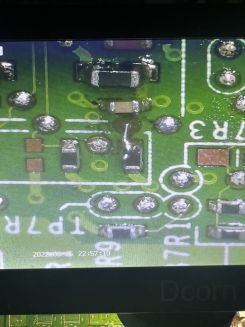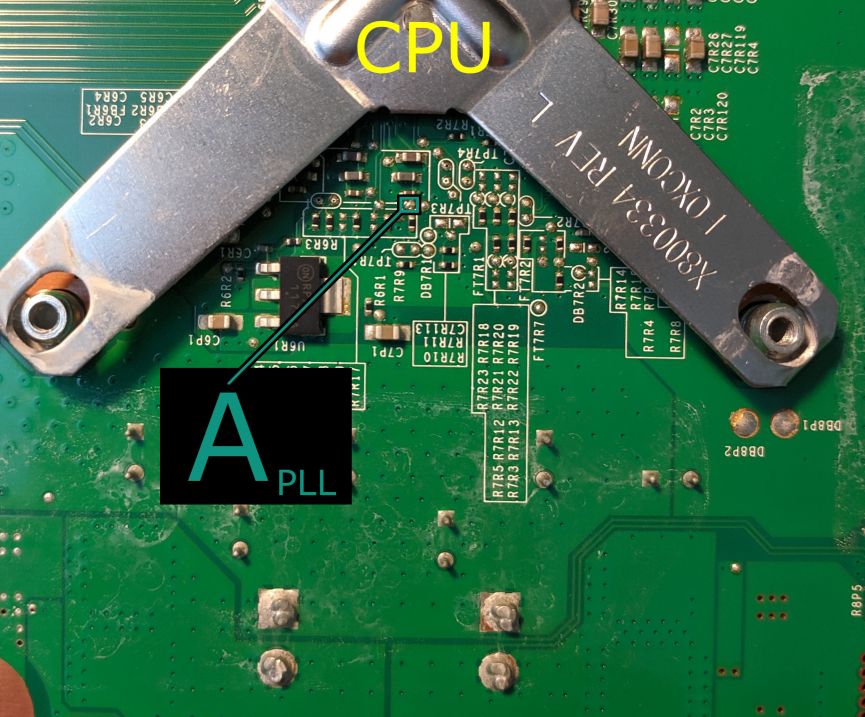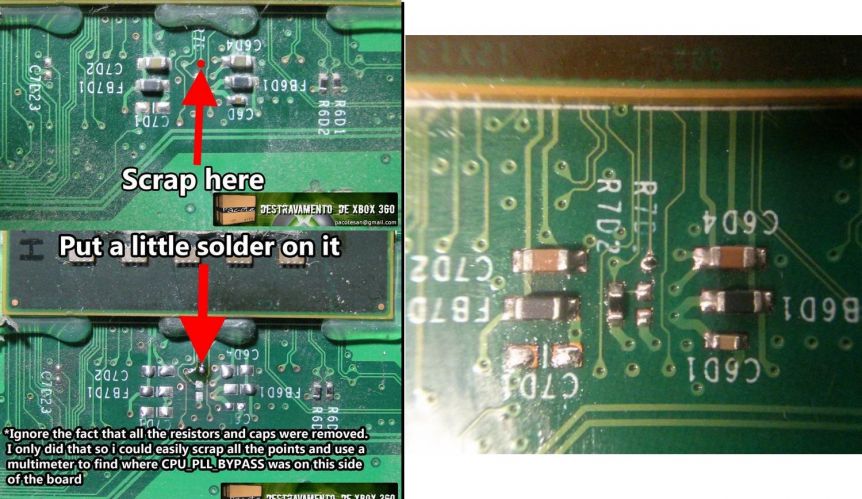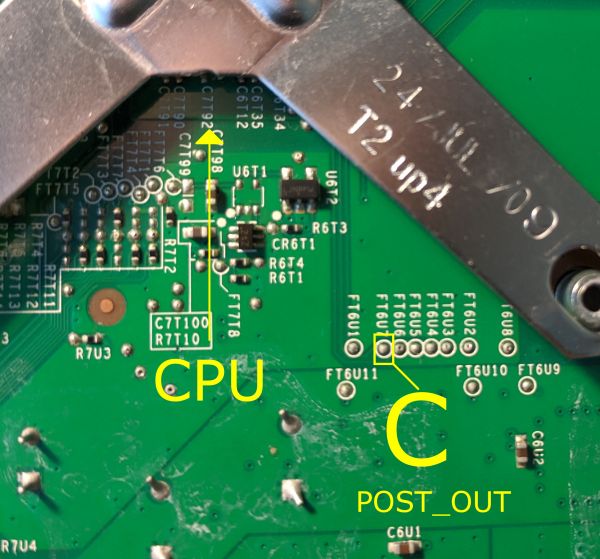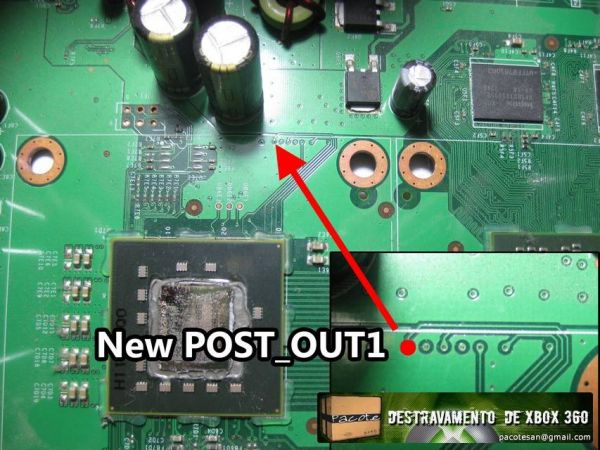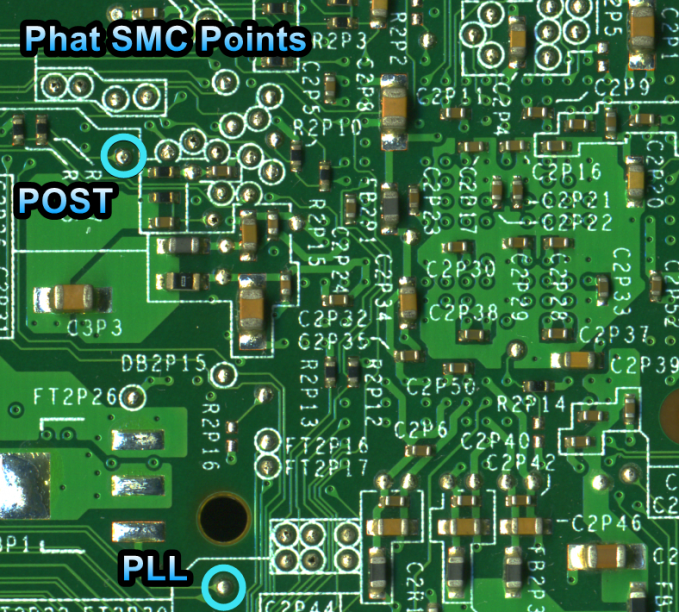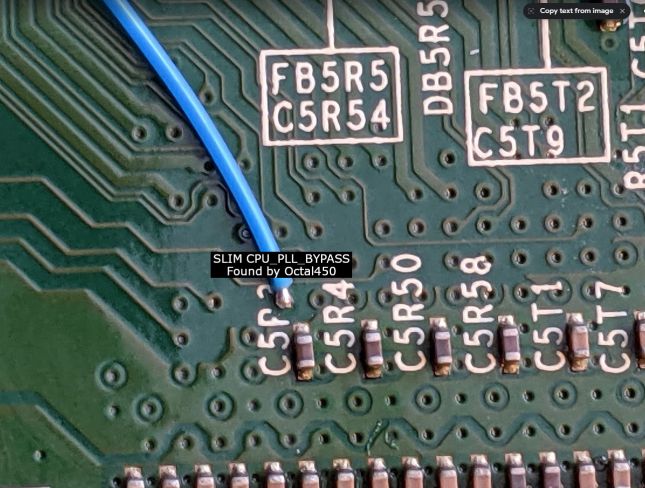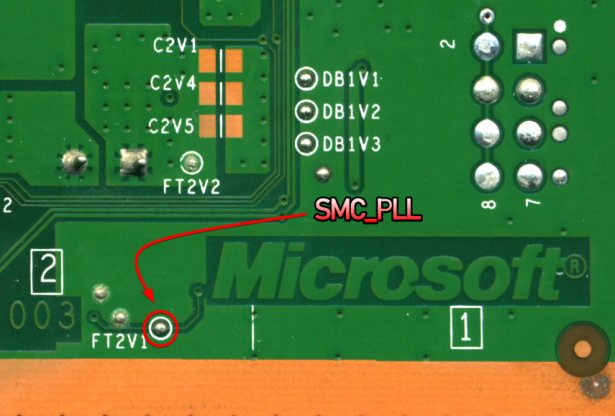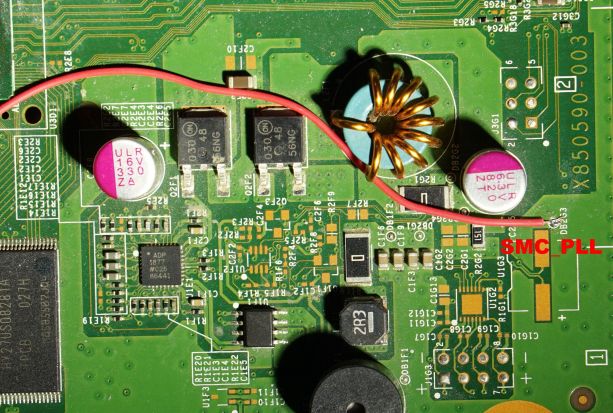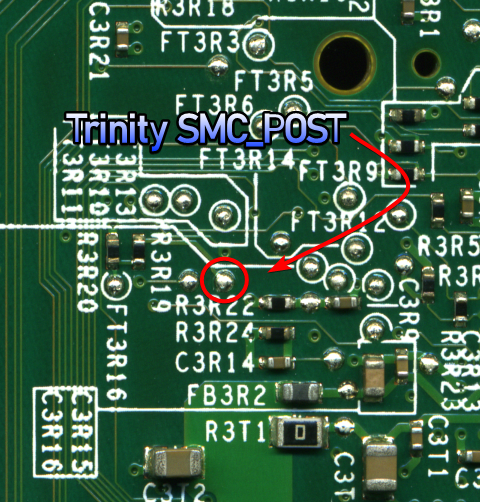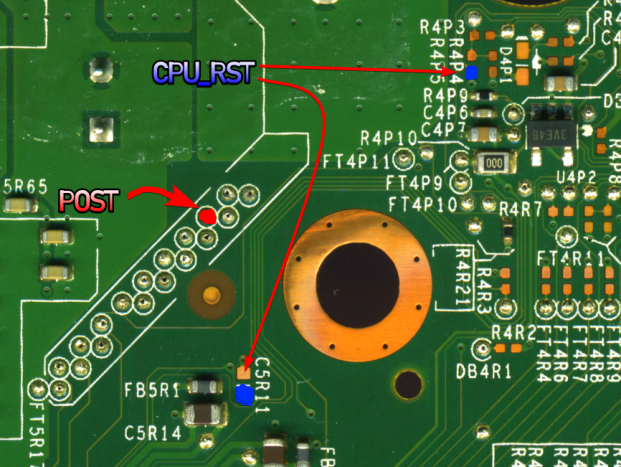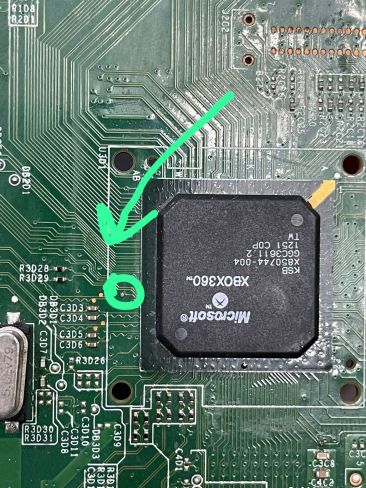Xbox 360:RGH/RGH3: Difference between revisions
| Line 10: | Line 10: | ||
**[[Recommended Soldering Equipment|Specific recommendatons can be found on this page]] | **[[Recommended Soldering Equipment|Specific recommendatons can be found on this page]] | ||
*28-30AWG Wire (Solid core recommended) | *28-30AWG Wire (Solid core recommended) | ||
*An SMD or through hole resistor ('''Required on Phat''', optional on Corona. Optional but highly recommended on Trinity.) | *An SMD or through hole resistor, SMD preferred. ('''Required on Phat''', optional on Corona. Optional but highly recommended on Trinity.) | ||
**Falcon/Jasper: 22K Ohm (Red, Red, Orange, Yellow) | **Falcon/Jasper: 22K Ohm (Red, Red, Orange, Yellow) | ||
**Trinity: 3K to 10K Ohm | **Trinity: 3K to 10K Ohm | ||
| Line 16: | Line 16: | ||
***Some Trinity consoles can occassionally have issues with RGH3 when using a high Ohm resistor, so it's best to start with around 3K when using one. | ***Some Trinity consoles can occassionally have issues with RGH3 when using a high Ohm resistor, so it's best to start with around 3K when using one. | ||
**Corona: 1K Ohm (Brown, Black, Red, Gold) | **Corona: 1K Ohm (Brown, Black, Red, Gold) | ||
* | *A diode of your choice, SMD preferred. | ||
**Only used with Falcon/Jasper; highly recommended for stubborn consoles) | |||
*Wire Insulation (kapton tape, electrical tape, heatshrink, etc.) if using a through hole resistor/diode | *Wire Insulation (kapton tape, electrical tape, heatshrink, etc.) if using a through hole resistor/diode | ||
*A PC running Windows Vista or later | *A PC running Windows Vista or later | ||
Revision as of 21:41, 3 April 2024
| The steps on this page are considered risky for your console, as there is a chance you can brick it. Please have someone else mod your console if you are not experienced in soldering! |
| Phat consoles tend to be more stubborn with RGH3, and may have inconsistant booting behavior. It is recommended to use RGH 1.2 on a phat system, as it will be more stable. |
RGH 3 is a modern method of the Reset Glitch Hack that uses the SMC in the Xbox 360's southbridge instead of a glitch chip in order to boot unsigned code.
MrMario2011 has video guides for RGH 3 on Falcon/Jasper[1], Trinity[2], and Corona [3] motherboards respectively. The guides from Larvs on Xbox 360 Hub[4] and BeefyDJ on Se7enSins[5] are also great resources for RGH 3 tutorials.
Equipment Needed
- A soldering iron, solder, flux, and Isopropyl alcohol with cotton swabs
- 28-30AWG Wire (Solid core recommended)
- An SMD or through hole resistor, SMD preferred. (Required on Phat, optional on Corona. Optional but highly recommended on Trinity.)
- Falcon/Jasper: 22K Ohm (Red, Red, Orange, Yellow)
- Trinity: 3K to 10K Ohm
- 10K resistor color values are Brown, Black, Red, Gold
- Some Trinity consoles can occassionally have issues with RGH3 when using a high Ohm resistor, so it's best to start with around 3K when using one.
- Corona: 1K Ohm (Brown, Black, Red, Gold)
- A diode of your choice, SMD preferred.
- Only used with Falcon/Jasper; highly recommended for stubborn consoles)
- Wire Insulation (kapton tape, electrical tape, heatshrink, etc.) if using a through hole resistor/diode
- A PC running Windows Vista or later
- J-Runner with Extras
- Any compatible NAND Programmer
Reading your NAND
4 GB Corona/Waitsburg/Stingray
4 GB Xbox 360 S/E SKUs made after mid 2011 use an MMC NAND (Corona) or eMMC chip (Waitsburg/Stingray/Winchester) and require different tools to dump and flash the NAND compared to the 16/64/256/512 MB NAND chips. These 4 GB consoles require that you use an xFlasher 360, PicoFlasher, Element18592's 4GB USB tool, or an SD card tool. Consider the pros and cons below and choose the method that’s right for you.
A guide on how to dump and write to a 4 GB NAND can be found here.
| Device | Pros | Cons |
|---|---|---|
| xFlasher 360 |
|
|
| PicoFlasher |
|
|
| 4GB USB Tool |
|
|
| SD Card Tool (any brand) |
|
|
All Other NAND Types
There are a few different tools for reading your NAND chip: xFlasher 360, Nand-X, JR Programmer, Matrix USB NAND Flasher, PicoFlasher, various SD card tools, or a LPT cable. Consider the pros and cons below and choose the method that’s right for you. An LPT cable is not recommended as it's extremely slow, requires more work than other options, and cannot be used to program glitch chips.
A guide on how to dump and write to a standard NAND can be found here.
| Device | Pros | Cons |
|---|---|---|
| xFlasher 360 |
|
|
| PicoFlasher |
|
|
| JR Programmer |
|
|
| Nand-X |
|
|
| Matrix USB NAND Flasher |
|
|
| LPT Cable |
|
|
RGH3 Wiring & Diagrams
Phat (Falcon/Jasper)
On Falcon and Jasper motherboards, you can place a diode on the wire that connects POST and SMC_POST. While it could be skipped, it is more likely the console's boot times will be more unstable or inconstant without it.
The diode's cathode end (the side with a black band) connects to CPU POST, whereas its anode end connects to SMC_POST. Make sure the polarity is correct.
When using a through hole component, it is recommended to solder it inline the wire instead of soldering it directly to a pad. The wires will be less stiff than the component's legs, causing less strain to the joint if it moves around. Make sure the PLL wire is not nearby any high noise areas, like capacitors or coils.
It is not recommended whatsoever to use RGH 3 on Falcon or Jasper without the suggested resistor.
CPU Solder Points
CPU PLL
CPU POST
SMC Solder Points
Slim (Trinity)
On Trinity, it is optional but highly recommended to use a 3K to 10K Ohm resistor on the PLL wire. The diode on the POST wire is not used on Trinity.
When using a through hole resistor for PLL, it is recommended to solder it in the middle of the wire instead of soldering it directly to a pad or via. The wires will be less stiff than the diode's legs, causing less strain to the joint if it moves around.
Make sure the PLL wire is not nearby any high noise areas, like any coils or capacitors.
CPU Solder Points
SMC Solder Points
Slim or E (Corona/Waitsburg/Stingray)
The 1K Ohm resistor on Corona motherboards is entirely optional, but recommended for CPU reliability if available. It also goes on the wire connecting SMC_PLL and the CPU's PLL.
When using a through hole resistor for PLL, it is recommended to solder it in the middle of the wire instead of soldering it directly to a pad or via. The wires will be less stiff than the diode's legs, causing less strain to the joint if it moves around.
Make sure the PLL wire is not nearby any high noise areas, like any coils or capacitors.
Make sure to check if the POST point on the bottom is enabled or not using the provided diagram. The diode on the POST wire is not used on Corona.
CPU Solder Points
SMC Solder Points
Testing the Console
Once you've finished soldering, clean up any flux with isopropyl alcohol and cotton swabs. Partially re-assemble your Xbox 360, ensuring that:
- Heatsinks are attached (If they were removed for some reason)
- Fan(s) are in place and plugged in (On a phat console, the fans can be angled on top of the heatsinks to cool them for testing)
- The RF board is plugged into the front of the console
- An A/V or HDMI cable is plugged into the Xbox 360 and into a TV or monitor
- A power brick is plugged in to both the wall and Xbox 360
- (Optional) An ethernet cable is plugged into the Xbox 360 and a LAN (e.g. a switch, router, or directly to a PC)
Turn on your console, and it should boot into XeLL RELOADED within a minute. If you don't have an ethernet cable connected, write down (and/or take a picture of) the "CPU Key" listed on screen. If the console doesn't boot into XeLL, check all previous steps and double check your wiring accuracy and quality.
Decrypting the NAND
Once you have successfully obtained your CPU key, we can build an XeBuild image, which is a modified NAND built specifically for your console.
- If you want to use J-Runner with the console connected to LAN to get the CPU key, enter the IP address XeLL gives you into the lower right of the app. You can then click
Get CPU Keyand J-Runner will automatically decrypt the retail NAND dump you backed up earlier. - If you want to use XeLL's web page to get the CPU key, enter the Xbox's IP address in your preferred web browser. You will see information about the console, and the CPU key can be easily copy and pasted from this web page.
- If you didn't have access to an ethernet cable to plug the Xbox into a PC or LAN, you can manually type the CPU key into J-Runner in order to decrypt your original NAND dump.
You may want to extract the contents of your NAND before going further for backup purposes, like your original keyvault. Here is how to do so.
- Add your original NAND dump to J-Runner using the
Load Sourcebutton. It will be either namedflashdmp.binornanddump(1/2).bin. - Select the button above the Source NAND's text field named
Extract Files. - You will now have backups of the original console's keyvault, SMC configuration, and SMC firmware.
Writing New NAND Image (NAND Flasher)
- Power down the console, and connect your programmer to the motherboard.
- If you are using an xFlasher, ensure the switch is set to
SPI.
- If you are using an xFlasher, ensure the switch is set to
- Open J-Runner and select
...next to the Load Source field and select one of your original NAND dumps if not already selected. In the upper right of J-Runner, ensure theGlitch2radio button is selected.- Since RGH3 XeLL was written to the NAND earlier, Glitch2 and RGH3 should already be enabled.
- Click "Create XeBuild Image". This will take a few moments.
- Click "Write NAND".
- Disconnect your NAND programmer from the console's motherboard when the process completes.
- Check if the console boots to the Microsoft dashboard. If it successfully boots to the dashboard, it is an indication that you've successfully hacked your console.
- Boot the console several times and ensure it boots consistently. If not, make sure your wiring is clean and neat and avoids noisy areas. Run the wires near the X-Clamps for best results.
- If you are on a Falcon/Jasper console and have issues with booting, you can configure the RGH 3 MHz in J-Runner from 10 Mhz to 27 MHz or vise versa.
- Continue in the Cleaning Up section.
Writing a New NAND Image (XeLL)
- Open J-Runner and select
...next to the Load Source field and select your nanddump1.bin or nanddump2.bin if not already selected. In the upper right corner of the window, select the dashboard version you chose for the patched dump that you wrote to the motherboard and make sure that theGlitch2radio button is selected.- Since RGH3 XeLL was written to the NAND earlier, Glitch2 and RGH3 should already be enabled.
- Click "Create XeBuild Image". This will take a few moments.
- Copy updflash.bin to a FAT32 formatted USB storage device and plug it into your powered-off console.
- Turn on your console. It will boot into XeLL and begin flashing your NAND. Once it has finished, it will power off your console.
- Turn it back on, and it should boot to the Microsoft dashboard, which is an indication that you've successfully hacked your console.
- Boot the console several times and ensure it boots consistently. If not, make sure your wiring is clean and neat and avoids noisy areas. Run the wires near the X-Clamps for best results.
- If you are on a Falcon/Jasper console and have issues with booting, you can configure the RGH 3 MHz in J-Runner from 10 Mhz to 27 MHz.
- Continue in the Cleaning Up section.
Cleaning Up
Remove the NAND programmer wires from the console and clean the points. Clean all flux off the board, allow it to dry, and test it once more before re-assembling.
You may want to leave your Xbox 360 disassembled so that you can disable the eFuse-blowing circuit so you can't accidentally install official updates on your console.
Installing XeXMenu
- Plug a flash drive into your Xbox 360 and navigate to Console Settings > Storage. Select the flash drive and allow the console to format the flash drive.
- Extract the
CODE9999folder from XeXMenu 1.2 rar to your Desktop. - Plug the flash drive into your PC. Create a new folder on the flash drive and name it
0000000000000000(16 zeroes). Open the new folder, then drag theCODE9999folder into it. - Safely eject your flash drive and plug it into your Xbox 360. Navigate to the Demos section of your dashboard, and it should list XeXMenu there. Select it to launch it.
- You can install XeXMenu to your hard drive by going to Console Settings > Storage, and copying it from your flash drive to the hard drive.
From here, you can install any homebrew or mods that you want. See this page for a list of recommended modifications and applications to install.
